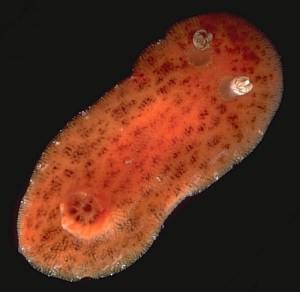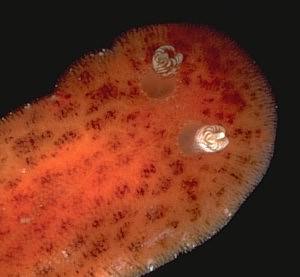

Rostanga calumus
Rudman & Avern, 1989
Order: NUDIBRANCHIA
Suborder: DORIDINA
Family: Dorididae
DISTRIBUTION
Known from New South Wales, Victoria, Tasmania and the southern part of Western Australia.
PHOTO
Rocky Cape, Tasmania, Australia. two specimens (13, 16 mm long alive), 22 February 1984, AM C141312. Photos: Bill Rudman
See also R. calumus - Radula.
The animal ranges in colour from a reddish-orange to a yellowish-orange with patches of brown specks on the dorsal epithelium between the caryophyllidia. The closely spaced caryophyllidia on the mantle are a translucent orange except for the colourless protruding spicules. There are some scattered white specks and patches near the mantle edge some of which are small mantle glands and some just pigmentation. The rhinophore stalk is transparent and the club is translucent with a heavy dusting of white with some brown patches. The terminal knob is white. The overall impression is that the rhinophores are white but in some cases unusually heavy brown patching makes them appear quite brown. The gills are translucent with a colour similar to that of the background mantle. Microscopic brown specks are scattered over the gills. Across the flattened tip of each gill is a submarginal white band often with a row of brown specks forming a second band beneath it. The submarginal white band on each gill gives the complete gill circlet a characteristic submarginal white rim.
The mantle is ovate and is similar in shape to R. arbutus. The rhinophores have a stout stalk and the club consists of nine to ten almost vertical lamellae with a tall inflated terminal knob in the posterior mid-line. There are seven to nine tripinnate gills and the upper pinnules are arranged to give a wide flattened tip to each gill. The gills form a short upright cylinder.
The egg mass and development have only been observed on one occasion (Hunter & Woodward, personal communication, AM C152563). The eggs were a pale pink-orange and laid in a broad spiral ribbon, with shallow scallops along the outer edge. Planktotrophic larvae developed quickly beginning to hatch five days after oviposition and continuing to hatch for three further days. We have photographs of two specimens from Sydney associated with orange sponges. The two sponges appear to be different species. In neither case were the sponges collected so identification is impossible. One specimen from Western Australia (WAM 787-83) was found associated with an orange sponge which has been identified as Clathria (Clathria) cf. partita (.Microcionidae).
References:
• Rudman, W.B. & Avern, G.J. (1989). The genus Rostanga Bergh, 1879 (Nudibranchia:
Dorididae) in the Indo-West Pacific. Zoological Journal of the Linnean Society 96: 281-338.
Rudman, W.B., 2002 (February 4) Rostanga calumus Rudman & Avern, 1989. [In] Sea Slug Forum. Australian Museum, Sydney. Available from http://www.seaslugforum.net/factsheet/rostcalu
Related messages
-
Rostanga calumus from S.E. Australia
From: John Chuk, April 24, 2002 -
The egg ribbon of Rostanga calumus
From: Bill Rudman, April 23, 2002 -
Radula of Rostanga calumus
From: Bill Rudman, April 23, 2002 -
Re: Rostanga calumus? from S.E. Australia
From: Audrey Falconer, March 8, 2002 -
Re: Rostanga calumus? from S.E. Australia
From: Audrey Falconer, February 12, 2002 -
Rostanga calumus from S.E. Australia
From: John Chuk, February 8, 2002
